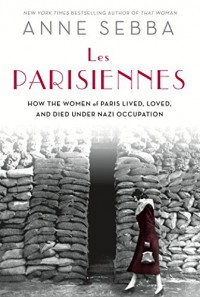18 Oct 2016

Disclaimer: ARC via Netgalley in exchange for an honest review.
Do we really need yet another book about Paris during the Second World War?
I don’t know the answer to that question. We do need this book, however.
In the past few years, it seems that the role of women in war is getting more attention and study, at least in popular culture. Hopefully, Hollywood will catch up and instead of the fictional Charlotte Grey we will have a lavish movie about the real Marie-Madeleine Fourcade, who also went by the name Hedgehog. Maybe instead of a one hour program on PBS Noor Khan will finally get her own Hollywood movie. Maybe in additional to Band of Brothers and The Pacific, HBO will finally have a series about women resistance fighters – and not the by now tried and tired cliché of the woman falling in love with the German officer she is suppose to be spying on. Don’t give me that. Give me Virginia Hall and Cuthbert. Please, please, someone do that.
For those of you that don’t know, Cuthbert is a wooden leg.
That’s not to say that such romances between German officers and French women didn’t happen. Sebba’s book does detail some of those relationships, though how many of them occurred between a woman resistance member and the man she was spying on, Sebba doesn’t say. (I do wonder why it is always that pairing in fiction at least).
Les Parisiennes chronicles the lives of French women, in particular those women of Paris, during the Second World War. Despite the book’s title, some of the women mention therein is not in Paris, usually because of the War. Sebba counts for this quite nicely by counting Parisenne as a style or sense instead just a living situation. And she really isn’t wrong when you think about it.
In many ways, Sebba’s book is important because it balances the women on the sidelines stories that seem to be so much of popular and easily accessible World War II history. It’s true that there are several books about the role of women in the British SOE, but it wasn’t until this year that WW II woman pilots (WASPS) could legally be buried at Arlington. Usually, there are a few general statements, books about women rescuers of Jewish civilians, and information about nurses. You really have to look to find books about women, and finding books in English about French resistance woman fighters is especially hard in some cases. So we do need books about this.
In another way, Sebba’s book is important because it is not just resistance members that she focuses on. She looks at what drove women to take the steps they did. She also looks at the lives of women who resisted passively or just lived. It isn’t just one type of woman that makes up the story, but many. In some cases, Sebba offers what could be seen as a corrective. This is particularly true of Rose Valland, who kept track of art that the Nazis stole. Nothing against Cate Blanchett, but the character based on her in Monuments Men was just insulting –and it is difficult to find information about Valland in English. Sebba gives you some. She also mentions other quasi well known women, such as Vera Atkins, Noor Khan, and other SOE agents. She details Colette and Chanel as well. In the case of Chanel, one does want a bit more detail about the collaboration she might have/did does with the Nazis. The focus is women of all sort and types – Jewish, communist, mothers, fighters, you name it.
In fact, if there is a weak point in the book, it is about the collaborators. In many cases, there seems too little about women who collaborators. This is not to say that she does not deal with it. Quite frankly, I would be willing to forgive the book more grievous sins simply for the section that deals with the head shaving of women upon liberation of Paris. Sebba looks at what drove people, mostly men, to do it as well as the reactions of those in Paris who saw it. It is a very detailed and compelling section.
Sebba divides the book up into sections based upon time; therefore for each year of the war as well as the years of liberation and rebuilding. She follows some women throughout the timeline (and not everyone survives). At times, she travels far from Paris, for instance to Ravensbruck where many Parisian women were sent. At other times, she seems to reach a bit too far – the presence of Jacqueline Bouvier while showing how close to returning to normal Paris was feels a bit too forced. Yet, the timeline does allow her to show the use of culture – some fashion houses stayed home for instance – as well as the need to find food. She traces how women involved in some political movements, such as Communist groups, rose to lead protests about food shortages. She shows how women rising to take care of family during the absence of men, pushed society forward despite what both the Germans and Vichy government tried to do.
Sebba’s book is the type of a book we need about war. It isn’t about the armies or the rescuers (or at least just the rescuers), it is about a group that during many wars is simply seen as something to possess.
 1
1








